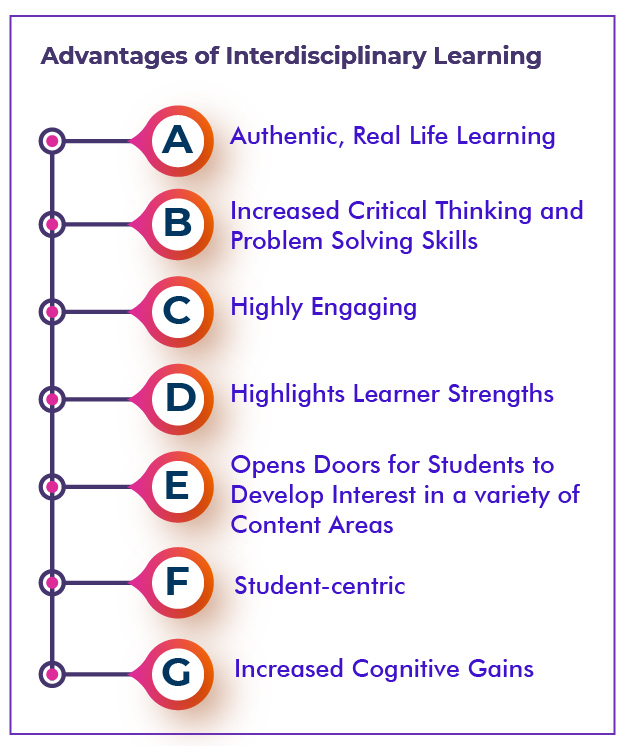An interdisciplinary approach consists of multiple perspectives in a bid to integrate those perspectives into a coherent structure. Interdisciplinary teaching is gaining immense popularity in the field of education especially higher education and crossing subject boundaries is a growing theme in recent years. 21st century educators are expected to be learners of varied disciplines and break free from the watertight compartment of a single discipline if they are to prepare their students as global citizens ready to face a complex world and somewhat uncertain future. Colleges and universities around the world are bracing interdisciplinary teaching as a means to usher in this new form of education with emphasis on interdepartmental collaboration dismantling the walls around individual subjects.
Higher education seems to be at the crossroads today and is undergoing massive transformation. This can be seen as a paradigm shift in the landscape of higher education and not without its share of benefits both for the teacher fraternity and the students as well as the entailing challenges.
Main Purposes of Interdisciplinary Teaching
The ultimate purpose of interdisciplinary teaching is to enhance teamwork and collaboration among the disciplines and areas of work with an aim to strengthen the best practices of the disciplines involved. As interdisciplinary teaching is getting widespread recognition, academicians are setting similar goals as follows: -
- Encouraging teamwork by creating an environment of collaboration of allied disciplines
- Fostering an awareness of the interconnection of various disciplines
- Gaining an insight into other disciplines and building a strong understanding
- Enhancing communication among the disciplines in a productive learning environment
- Achieving effective learning among disciplines by mastering different vocabulary
- Cognitive and social development of students and educators
- Acquiring knowledge in other disciplines’ rules, beliefs and ethical principles
Apart from learning about each other’s work, research and academic disciplines, interdisciplinary teaching aims at the development of the level of human cognition that stimulates ideas and thoughts about a topic, taking into account various points of view and unthought possibilities. The final outcome of interdisciplinary higher education is higher level of cognitive processing i.e. the ‘wisdom’ as defined by psychologists.
Quoting Joseph W. Meeker wisdom can best be described as “a state of the human mind characterized by profound understanding and deep insight.”
Potential Framework for Interdisciplinary Teaching
A structured approach to interdisciplinary teaching can lead to interdisciplinary curricula which can provide students the opportunity to develop and draw knowledge from multiple disciplines. This creates a pathway to interdisciplinary learning which forms the basis of interaction and integration of knowledge from different disciplines and working on an overarching topic or theme that shapes the learning experience. This kind of interdisciplinary framework gives birth to new ideas, concepts, and perspectives, resulting in a synergy of distinct perspectives that could aid in finding innovative solutions to major social and technological issues. With well-planned course structure, two or more disciplines can work together to bring amazing results to a problem that one discipline alone may lack. When we integrate sociology, political science and history, we can have a deeper study on human behaviour.
Higher education institutions are getting drawn towards this form of teaching. University academicians are placing value on interdisciplinary education and their willingness seems to be conspicuous as many are voicing their interest in an interdisciplinary curriculum which has an appeal.

Interdisciplinary teaching has an array of benefits for the students: -
- Students learn to apply knowledge creatively leading to better understanding.
- Interdisciplinary teaching develops mental framework that prepares students for lifelong learning.
- It provides a holistic approach to learning strengthening the cognitive ability.
- It gives a new dimension to the study of concepts and complex issues.
- Interdisciplinary teaching paves the way for collaboration and teamwork across disciplines.
Even the educators can benefit a lot from interdisciplinary teaching which:
- Aids in thorough comprehension of disciplinary concepts and contexts.
- Fosters collaboration across subject groups and interlinked topics.
- Allows subject experts to share accurate content, methods and skills.
- Offers opportunities for rich and authentic professional development.
- Highly effective for those pursuing professional doctoral programs.
Challenges of Interdisciplinary Higher Education
Psychologist Howard Gardner has discussed about the chances and challenges of interdisciplinary education, specifically within the context of a discipline-specific institution. Gardner opined: “The question of interdisciplinary study proves timely. At the beach-heads, most problems do not readily fit into neat disciplinary niches. Teams of interdisciplinary workers are the norm . . . And yet, interdisciplinary work proves challenging, as it requires the wedding of often disparate methods and ways of thinking.”
There are surely some challenges that work against this pattern of teaching. First, there is time constraint within a set course structure to cover adequately another discipline’s knowledge base and every time to bring in that interdisciplinary learning experience.
Educators engaging in interdisciplinary teaching might need extensive preparation or time and the background and expertise of discipline-specific faculty may not be sufficient to disseminate knowledge of another discipline in an accurate manner.
It is likely that many aspects and major components existing in the other disciplines may get side-lined or interpreted as unimportant leading to omission within the “interdisciplinary” focus integrated into an existing course.
There is not much opportunity for students to interact with experts or peers educated in the other disciplines. The outcome, therefore, may be ordinary and not as per the expectations set.
Conclusion
However, the impact of interdisciplinary teaching can be profound but the aim of this form of learning must be well-structured so that students will be able to apply the knowledge and skills in purposeful, interdisciplinary interaction. From the curriculum development standpoint, this emphasizes the need to acquaint students with specific skills (discovery, understanding and interpretation) and to develop and integrate knowledge of corresponding disciplines and apply these to use in larger projects examining and addressing genuine interdisciplinary issues and solving bigger problems. Further research is needed to explore the appropriateness of this pattern of teaching. An analysis of students’ interdisciplinary interactions will also provide new information. But there is no denying the fact that socialization resulting from interdisciplinary approach can subtly shape the ways of thinking of the students as the specialists from different domains collaborate to prepare future graduates who will have the ability to tackle complex problems wisely.
Written By : Rebecca Wilson

